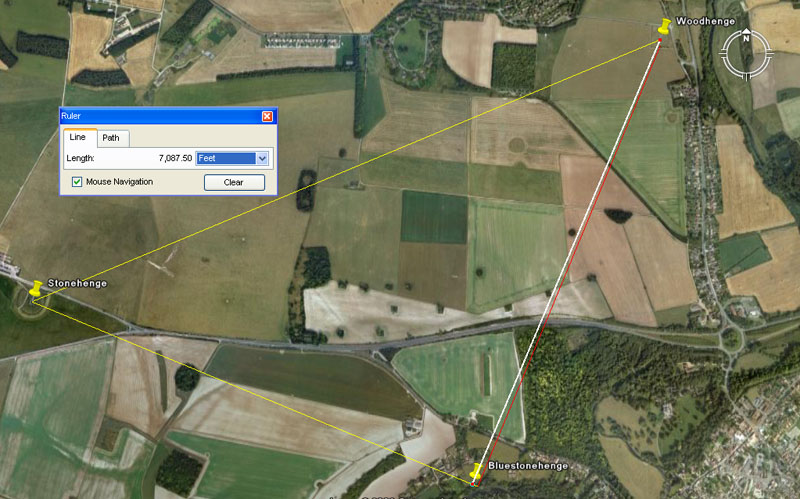
BLUESTONEHENGE
The sites called Stonehenge and Woodhenge are well known around the entire world, but Bluestonehenge is yet another circle site in the near vicinity of the other two which has only newly been found.
During excavations of the site in 2009 it was discovered that the empty holes where large stones once stood contained fragments of bluestone, indicating the type of marker that once filled the holes. These were plundered or removed long ago and, because Stonehenge has an inner ring of bluestones, it's now theorised by some archaeologists that the source of those markers was nearby Bluestonehenge when that circle site fell into disuse.
Bluestonehenge sits adjacent to the Avon River at Amesbury, about 1.5-miles distant south of the point where Durrington Walls Henge (the largest known henge site in Europe) also sits adjacent to the Avon. The river meanders back and forth for about 3.75-miles between the two water-linked sites and appears to have been fully navigable by small boats throughout this stretch. Durrington Walls Henge even had a metaled road leading to the river.
The latest theory postulated by our archaeologists is that Stonehenge and related sites in the near vicinity were all built solely for ceremonial, ritualised disposal of the dead. Our archaeologists now provide us with a nauseating vision of the Stonehenge lintels adorned with rotting down corpses and general putrefaction or frequent solemn funerary processions marching along the Avenues to carry dead dignitaries to the giant mausoleum.
The newly found Bluestonehenge is represented as the first port of call by the river bank for the incoming cadavers and their entourage of mourners arriving by river craft. It's even been suggested that bodies might have been cremated within the circle of bluestones and the ashes then carried to the Stonehenge site, etc.
In all of this speculation our ancestors are reduced to the lowest common denominator possible, as semi-savage, deeply superstitious individuals, involved not only in ritual human sacrifice to appease their blood-thirsty gods, but showing an obsessive, unhealthy interest in the subject of death.
However, our archaeologists have seriously neglected to look at the positions of these several regional circle sites in relation to each other or to the mounds and sundry, purpose placed markers that stand some distance out from them. In their rush to label our ancestors as backwards-primitives, the modern-day experts have overlooked sophisticated scientific information that was anciently coded into the vast surrounding landscape. Perhaps it's time for our archaeologists to step aside and allow surveyors to make their separate clinical assessment of the outstanding evidence.

From the centre of Stonehenge a line runs for an intended 7087.5-feet and resolves upon a hump adjacent to Bluestonehenge's walkway to the Avon River. The azimuth angle from Stonehenge to this spot is 112.5-degrees around from North. Situated 7000-feet down this line is the centre of Bluestonehenge and the line proceeds an additional 87.5-feet beyond that point to resolve upon the hump. From the hump position, the line turns 90-degrees to an azimuth angle of 22.5-degrees and resolves upon the prominent, stand-alone southern marker of Woodhenge. Alternatively, from the centre of Bluestonehenge a line runs for 7087.5-feet to the centre of Woodhenge at an azimuth angle of 23.625-degrees.
The triangle provides three surveyor's baselines of known length from which accurate trigonometric calculations could be made onto any of the outlying markers and mounds, in view, within the surrounding landscape. Woodhenge appears to have functioned as a resolving centre for the surveyor's baselines, using particular central markers to achieve perfect distance and angle codes to both Stonehenge (10,000' away at an azimuth angle of 247.5°) and Bluestonehenge.
Note also that within the "triangle" a series of dark green patches or marks can be seen in the otherwise plowed or harvested fields. Also some larger, circular mounds can be seen and all of these features were ancient, purpose-built outer markers that related in coded distances and angles to Bluestonehenge's centre position. Such archaeological features have World Heritage protection, which usually means placing fences around them to ensure their ongoing preservation.
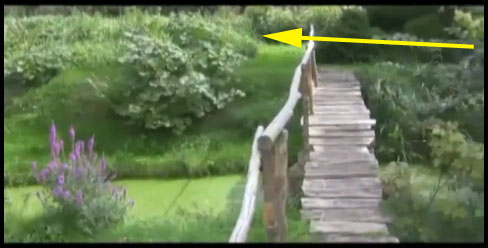
The line coming in from Stonehenge cuts through the centre of Bluestonehenge and resolves upon this riverside hump or near vicinity. The centre of Bluestonehenge and its associated markers is, therefore, equidistant to both Woodhenge and Stonehenge and their associated markers. This could only happen by very good surveying and not by chance.
To see the significance of the 7087.5-feet value, CLICK HERE
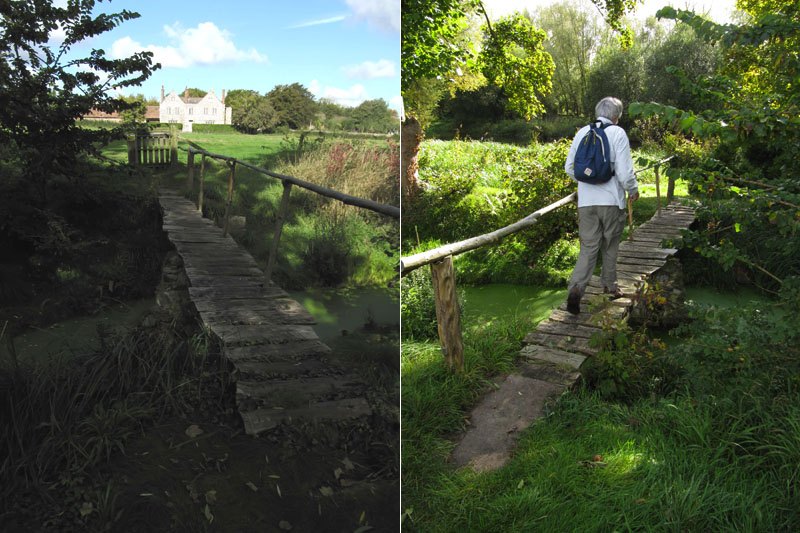
Left: The footbridge that runs adjacent
to Bluestonehenge circle on the eastern side is seen bathed in shadow. In the
background is the manor house built over the original ancient avenue that circuits
north towards Woodhenge then west to Stonehenge.
Right: American researcher, Richard Morrissey traipses over the footbridge and
streamlet to the bank of the Avon River. Just forward of him and to his left
the river bank position sits 7087.5' from Stonehenge at an azimuth angle of
112.5°. From that position beside Bluestonehenge the line turns 90°
and runs at an azimuth angle of 22.5° to resolve upon the southern marker
of Woodhenge. Photo courtesy of Paul Sperry.
So, what can we say about these anchor points in the regional geometry?
1. The azimuth angle of 112.5° extending from Stonehenge is in homage to 11.25°, which is 1/16th of a 360° circle. It must be remembered that the 360° system (attributed to the Sumerians and Babylonians) is very old. These 360° expressions are encoded into the English landscape before the supposed epoch of the Sumerians.
2. The 90° opposed angle from the hump to the southern marker of Woodhenge (22.5°) is in homage to 1/8th of a 360° circle.
3. The angle of the vector running for 7087.5-feet (coded distance) from the centre of Bluestonehenge to the centre of Woodhenge is 23.625° (235/8ths). This angle value is also a factor of the distance. Therefore: 7087.5 (strong lunar code) ÷ 23.625 (strong lunar code) = 300.
BLUESTONEHENGE LAYOUT
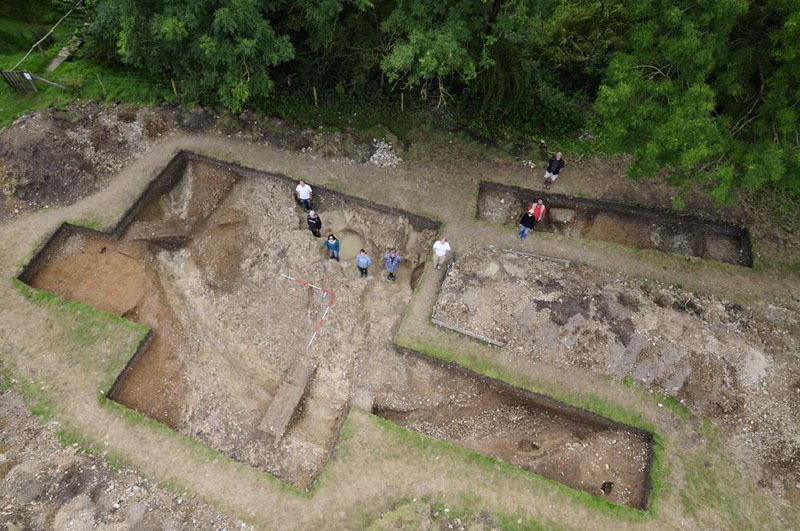
The Bluestonehenge archaeological team take up positions in the stoneholes, with the partially excavated henge curve in front of them. The small wooden overbridge and trackway to the Avon River is seen to the top left of the picture (Aerial-Cam photo, by Adam Stanford).
The Bluestonehenge site has been measured as 23.4 metres wide (77-feet) to the extremities of the circumnavigating ditch. The more inwards circle of stones had a diameter of just under 10 metres. There could have been as many as 25 bluestones (or less) in this circle, but only 9 holes were uncovered during the archaeological excavations before the site was refilled for future preservation. So what are the coded possibilities we can glean or surmise from these diameters and the circumferences derived therefrom?
1. In terms of the circuit for the edge of the ditch, the circle was probably intended to convey a coded diameter of 78.75-feet in one reading. Using PI @ 22/7ths this value creates an outer circumference of 247.5-feet. This is a very strongly represented code for the equatorial size of the Earth (24750) in miles of 5280-feet.
2. A second alternative would be a reading of 77.76-feet (another very strong code related to the Earth's equatorial circumference). Using PI @ 3.125, this converts to a circumference of 243-feet (a very strong lunar code).
3. Yet another tutorial would be based upon a diameter reading of 76.8-feet (a strong navigational code). This converts to a circumference of 240-feet (2/3rds of 360 and related to the compass) using PI @ 3.125.
All of the available evidence shows conclusively that the combined sites of Durrington Walls Henge, Woodhenge, Stonehenge and Bluestonehenge, working in conjunction with strategically placed mounds standing off from them in the outer landscape, functioned as a giant open air university for teaching principles of navigation and astronomy. In this function the overall, combined purpose was identical to that of Avebury Henge almost 20-miles to the North and it's surrounding appendage sites of clustered and individual mounds or standing obelisk marker stones.
Let's demonstrate the relationships between Bluestonehenge to surrounding mounds in the outer landscape and extract the navigational & astronomy tutorials that were being taught to generations of apprentice navigators during an epoch of 5000-years ago.
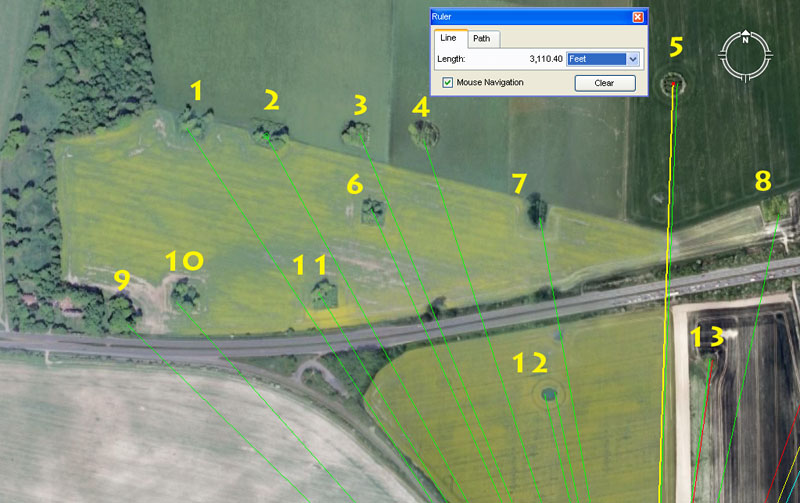
To the North of Bluestonehenge lie the "King Barrows" sets of mounds. This numbered grouping seen above sits to the East of the main King Barrows group and the mounds-markers are listed as archaeological sites on the World Heritage map of sites under protection in the area. Here are their apparent "codes of position" in relation to the hub position of Bluestonehenge:
1. The distance is 3500' and the azimuth angle is 326.7°.
The distance can be expressed as 3600 so-called Roman feet and 3600 ancient Swedish feet simultaneously. It is also 1/10th of an ancient Swedish Mil (mile). The same distance would equate to 1000 ancient Swedish Steg. The length converts fluidly into ancient Greek or Assyrian feet-cubits or Hebrew Reeds. It is 2/3rds of a Greek mile, etc., and was put in place on English soil a couple of thousand years before there was any semblance of Greek or Roman civilisations.
The angle provides a factorable number related to one of the main methods of configuring the equatorial circumference of the Earth for navigation. Under a second assignment found in the base dimensions of the Great Pyramid of Egypt, two circumnavigations of the edifice represented 6050' for 1-minute of arc in the Earth's circumference. Under this "11" based numerical system, the Earth was considered to be 24750-miles in equatorial circumference using miles of 5280' each. Rendered in feet this value would be 130680000'. The sum of 326.7° is in homage to 32670000', which would be 1/4th of the equatorial circumference under that highly factorable navigation system.
The codes of this mound-marker offer a precursor to what is to come. Every mound that sits off from particular henges in the region, such as Stonehenge, Durrington Walls Henge, Woodhenge, Bluestonehenge, Coneybury Henge or several others each offer sophisticated tutorials related to methods of navigation, the cycles of the Moon and calendar calculating methodologies. This whole region of multiple mounds and markers was an intensive school or open air university where generations of navigators and astronomers received their training by rote and grueling repetition. The essential scientific knowledge was given in numbers and these could be extracted by the students through precise measurement and angle determinations, then interpreted by the tutor as to meaning.
2. The distance is 3300' and the return azimuth angle to Bluestonehenge is 151.2°.
The distance is an "11" series value related to the mile of 5280' or ancient British league of 16500'. It would also equate to 5-furlongs (furrowlongs), 50 chains, 200 rods (perches), 600 ancient fathoms and 5000 links.
According to an expert on Viking measurements, Gary Anderson, one fot used by them was exactly 11". This would mean that this distance was 3600 ancient Viking feet. Alternatively, the Saxons had a fusse of 13.2" and this distance out from Bluestonehenge would equate to 3000 Saxon feet. The distance would also represent 1/39600th of the equatorial circumference of the Earth under the "11" based system of navigation. Note: the value 396 in half of 792 and the Earth is 7920 miles in diameter.
One point that needs to be made clear is that ancient mathematician-navigator-astronomers used many different "feet" of varied length in their calculations. The rules-calculators chosen for problem solving depended upon the type of problem that needed to be addressed, whether it be "miles" under the "11" number family, "miles" under the "6&7" families, "miles" under the "7" family, lunar calculations or calendar calculations, etc. Some rules like the 3 varied Egyptian Royal Cubits were specifically for calculating the equatorial circumference of the Earth under 3 separate navigational systems.
The azimuth angle is 151.2° and this is a navigational value found in the base dimensions of the Great Pyramid. Two base side lengths of the pyramid equate to 1512-feet and this distance equals 1/4th of 1-minute of equatorial arc for the Earth under the Great Pyramid's literal system. It could also be read as 1512.5' under the "11" family of numbers navigational system using the mile of 5280-feet and this would also have represented a tutorial in the mound-marker's position out from Bluestonehenge.
These values are very common in antiquity and occur repeatedly amongst the oldest known standards of Weights, Measures and Volumes. Please note that although numbers herein are sometimes accompanied with complex looking decimal fraction tails, these tails all translate to simple, common fractions used by the great civilisations since remote epochs in history.
BABYLONIAN DOUBLE STANDARD.
1 Talent………907200 grains,
equals:
60 Mina…….. @ 15120 grains, or:
3600 Shekel….@ 252 grains.
3. The distance is 3141.6-feet and the azimuth angle is 337.5°.
The tutorial in this distance was in homage to the PI ratio @ 3.1416, but would also have included other renditions such as 3.125 (31/8th), 3.141818182 (1728/550ths) , 3.142853142 (22/7ths) or 3.15 (33/8th) all of which represented forms of PI used in making particular kinds of ancient circle calculations that required a precise, whole number final answer on the circumference or in the diameter.
If the distance was read as 3150' then that would be 5 Greek Stadiums of 630' each. The same length would be 1750 Greek feet or 300 Hebrew reeds, etc. This length would equate to 3/5ths of a Greek mile.
The azimuth angle of 337.5° is a very strong lunar value simultaneously to being useful in navigational progressions.
4. The distance is 3024' and the azimuth angle is 162° return to the Bluestonehenge hubstone.
The distance is 1/2 of 1-minute or arc (equivalent to the distance of one circumnavigation of the Great Pyramid). Under this navigational system the world was considered to be 12 X 12 X 12 X 12 X 1.2-miles (24883.2) in circumference using Greek miles of 5250' each. This was a system that combined the numbers "6&7" and all values used were divisible by either 6 or 7.
The same outlying mound-marker would have also coded 3025', as this value represented 1/2 of 1-minute or arc for a world that was 24750-miles (of 5280' each) in equatorial circumference. This was the "11" system of navigation and all increments of length used were divisible by the number "11". This is the system which survived in Britain until metrification was forcibly introduced. The Americans still use the "11" series mile of 5280' and this increment is still encoded into the British landscape, as put there by surveyors over 5000-years ago.
The azimuth angle of 162° is in homage to the ratio of 1.6180339 to 1 and represents a rounded form of PHI used copiously in many ancient mathematical progressions. Two of the original Station Stones of nearby Stonehenge sat on this azimuth angle from each other (342° to 162°). The 162 value was highly important to calculations related to the lunar cycles, navigation and the Precession of the Equinoxes.
| GREEK VOLUMES…LIQUID (decimal fractions). | GREEK VOLUMES…LIQUID (fractions). |
| 1 Metretes…2332.8 cubic inches equals: | 1 Metretes…23324/5 cubic inches equals: |
| 12 Chous…..194.4 cubic inches, or | 12 Chous…..1942/5 cubic inches, or |
| 144 Cotyle…16.2 cubic inches, or | 144 Cotyle…161/5 cubic inches, or |
| 576 Oxybaphhon…4.05 cubic inches, or | 576 Oxybaphhon…41/20 cubic inches, or |
| 864 Cyathus…2.70 cubic inches. | 864 Cyathus…27/10 cubic inches. |
5. The distance is 3110.4' and the azimuth angle is 1.92° . Second angle reading onto part of the same mound is 2.25° .
With near-in mounds like this several closely related angle codes are achievable, but the further out a mound sits, the more stringently refined the angle becomes. For an outlying marker mound sitting several miles from a hub like Bluestonehenge, a mere variation of .1 of a degree to the angle can result in a wide miss of the mound position.
The distance taught students of navigation the equatorial size of the Earth, which was 12 X 12 X 12 X 12 X 1.2-miles or 24883.2-miles. By this very factorable method 1/8th part of the circumference or 22.5° of arc was 3110.4-miles.
| JERUSALEM LIQUID VOLUMES (decimal fractions). | JERUSALEM LIQUID VOLUMES (standard fractions) |
| 1 Cor…….18662.4 cubic inches equals | 1 Cor…….186622/5 cubic inches equals |
| 10 Bath….1866.24 cubic inches, or | 10 Bath….18666/25 cubic inches, or |
| 60 Hin……311.04 cubic inches, or | 60 Hin……3111/25 cubic inches, or |
| 180 Cab….103.68 cubic inches, or | 180 Cab….10317/25 cubic inches, or |
| 720 Log….25.92 cubic inches. | 20 Log….2523/25 cubic inches. |
There are at least two choices of coded degree angles that range out from Bluestonehenge and fall upon points of this outlying mound. One of these is 1.92°, which would encode a very dynamic value much used in navigation and mathematical progressions related thereto. A second reading could easily home in on a point of the mound that sat at 2.25° azimuth from Bluestonehenge's hub position and relate to tutorials about the 360° compass system. Of course a full number like 2° would also work in tutorials.
6. The distance is 2835' and the azimuth angle is 336° .
The distance carries a dynamic lunar code and is the same as one circumnavigation of the Khafre Pyramid of the Giza Plateau (Egypts pyramid of the moon). The sum of 2835-days would equate to 8 lunar years (@ 354.375-days each).
The angle relates to the equatorial circumference of the Earth and 33.6' would be 1/3rd of 1-second of arc (100.8') according to the Great Pyramid's literal geodetic assignment, where two circumnavigations of the edifice constituted 1-minute of Earth equatorial arc. Therefore 336' would be 1/18th of 1-minute of arc.
7. The distance is 2592' and the azimuth angle is 350° .
The distance relates to the 25920-year cycle of the Precession of the Equinoxes (72 X 360-years). One of the codes built into the rear face of the Heel Stone at Stonehenge is 259.2' distance from the centre of the site, thus coding this same scientific value.
8 The distance is 2625' and the azimuth angle is 12°.
The distance is exactly half of (what much later became known as) a Greek mile of 5250' ("6&7" family of numbers). It is also a very strong lunar code and a mathematical progression based upon, say 26.25 will produce a string of numbers that were highly useful in doing doing both navigational and lunar computations simultaneously. The sum of 259.2 X 26.25-days = 6804-days or the duration of the long lunar cycle where the Moon goes from Lunar Major Standstill to Lunar Minor Standstill and then returns to Major Standstill again.
HEBREW DESERT WEIGHT (HEAVY).
A second tutorial contained within this mound's position would have related to 2640' or half a mile using the mile of 5280' ("11" family of numbers). Amongst several of the cousin nations the "11"-series mile remained popular for navigation right up until modern times.
9. The distance is 3024' and the azimuth angle is 314.16°.
The distance is exactly half of 1-minute of Earth equatorial arc, based upon circumnavigating the Great Pyramid one time (3024' @ 756' per side). The way the ancient mathematicians set out the very factorable system was to call the equatorial circumference 12 X 12 X 12 X 12 X 1.2 Greek miles of 5250' each (24883.2-miles) or 130636800'. Under this "6&7" system 1° of arc was 362880', 1' of arc was 6048' and 1" of arc was 100.8'.
The tutorial related to this mound would also have meant 3025' or half a minute of equatorial arc under the "11" family of numbers. By this system the length of the Great Pyramid was symbolically read as being 756.25' per side (3" longer). Under this versatile navigational system the equatorial circumference was factored to be 24750-miles of 5280' each (130680000'). Therefore 1° of arc was 363000', 1' of arc was 6050' and 1" of arc was 100.833333'.
The degree angle is in homage to the PI ratio @ 3.1416. The angle would also have contained tutorials related to other very close proximity renditions of π used in various ancient calculations. The main objective in navigation when converting diameters to circumferences was to achieve a full, factorable value in the circumference reading and vice-versa. Therefore, all calculations using a "6&7" diameter increment (like the mile of 5250') used PI @ 22/7. All calculations using an "11" diameter increment (like the mile @ 5280') used PI @ 1728/550. This meant that circumferences were perfectly divisible within a 360° environment, which made positional plotting on sea charts quite fluid and easy to undertake. There were other renditions of PI like 3.125 and 3.15, which were also used in various kinds of calculations. The Greek half-stadia was 315' and that's the inner circumference of the Sarsen Circle at Stonehenge, a few thousand years before there was a Greek civilisation.
10. The intended distance for this tutorial is 2953.125' and the azimuth angle is 138.24° return back to the Bluestonehenge hub.
The distance is in homage to the lunar month of 29.53125-days.
The return degree-angle is navigational and relates to the equatorial circumference of the Earth when read as 24883.2-miles. The sum of 138.24-miles would be 1/180th of the equatorial circumference.
11. The distance is 2625' and the azimuth angle is 148.5° return.
Once again, the distance is half a Greek mile of 5250' (also 500 reeds or 5000 Greek feet), but another marker on the mound would have identified 2640' or half a mile @ 5280'.
The degree angle is navigational and provides a means of making readings of the equatorial circumference in Egyptian Royal Cubits related to the mile of 5280'. There were 3 main Royal Cubits and the one related to the "11" family of numbers was 20.625" in length. The sum of 1485' would equate to 864 Royal Cubits of this type. The main function of this cubit was to factor the equatorial circumference of 24750-miles (of 5280' each).
12. The distance is intended to convey 1866.24' and the angle is 166.6666666° return. Second angle reading: 168°.
The distance is navigational and relates to the 130636800' (24883.2-Greek miles) equatorial size of the Earth, of which 186624' would be 1/700th of the circumference.
| JERUSALEM LIQUID VOLUMES (decimal fractions). | JERUSALEM LIQUID VOLUMES (standard fractions) |
| 1 Cor…….18662.4 cubic inches equals | 1 Cor…….186622/5 cubic inches equals |
| 10 Bath….1866.24 cubic inches, or | 10 Bath….18666/25 cubic inches, or |
| 60 Hin……311.04 cubic inches, or | 60 Hin……3111/25 cubic inches, or |
| 180 Cab….103.68 cubic inches, or | 180 Cab….10317/25 cubic inches, or |
| 720 Log….25.92 cubic inches. | 20 Log….2523/25 cubic inches. |
The return angle from the mound would have carried a code of 166.6666° (1/3rd of 500). A 3,4,5 triangle has one side that is 1.666666 less in length than the hypotenuse. The angle of 168° (a value in a progression that produces dynamic navigational and lunar numbers simultaneously) was also a coded possibility upon part of this mound.
| HEBREW CUBIT OF A MAN (decimal fraction). | HEBREW CUBIT OF A MAN (fraction). |
| 1 Cubit….. 16.8 inches equals: | 1 Cubit….. 164/5 inches equals: |
| 2 Span….. 8.4 inches, or | 2 Span….. 82/5 inches, or |
| 4 Hand…. 4.2 inches, or | 4 Hand…. 41/5 inches, or |
| 24 Finger…. .70 inches. | 24 Finger…. 7/10 inches. |
13. The distance is 1980' and the azimuth angle is 7.5° .
The distance relates to the diameter of the Earth (7920-miles), of which the value of 1980-miles would be 1/4th part.
| ROMAN DRY MEASURE (Decimal fractions). | ROMAN DRY MEASURE (Fractions) |
| 1 Amphora…….1900.8 cubic inches equals: | 1 Amphora…….19004/5 cubic inches equals: |
| 3 Modius………633.6 cubic inches, or | 3 Modius………6333/5 cubic inches, or |
| 32 Choenix…….59.4 cubic inches, or | 32 Choenix…….592/5 cubic inches, or |
| 48 Sextarius……39.6 cubic inches, or | 48 Sextarius……393/5 cubic inches, or |
| 96 Hemina……...19.8 cubic inches. | 96 Hemina……...194/5cubic inches. |
The angle is related to the compass of 360° simultaneously to providing progressions within the so-called Greek system of navigation, wherein 75' would be 1/70th of a mile.
This gives us a glimpse of some of the codes of position inherent in the mounds that stood off from Bluestonehenge, but let's now test the same mounds and a few others in terms of their coded relationship to the hub position of Woodhenge.